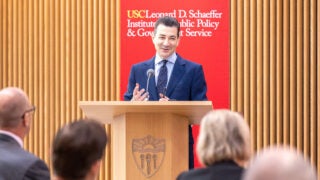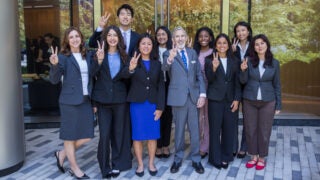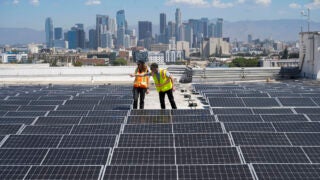Can Technology Beat the California Drought?
With California wilting during a drought that could last 20 years or longer, USC researchers wade through ways LA might tap a sustainable water supply.
It’s another cloudless day in drought-stricken Southern California. A patio umbrella shields Kelly Sanders from the midday sun outside the USC Viterbi School of Engineering. Sanders, an assistant professor in the Sonny Astani Department of Civil and Environmental Engineering, is talking about the surprising amount of energy it takes to bring in and manage our water supply. Nearby, a courtyard fountain burbles. Los Angeles wouldn’t be here—at least not in its current shape—if it weren’t for this imported water.
USC researchers are advancing policy on smart water use and creating technology to reuse, purify and desalinate water.
“A large fraction of that water is probably coming from Arizona,” Sanders says of the fountain’s splashing droplets. The water has likely been diverted from the Colorado River Aqueduct’s point of origin, some 245 miles away at Lake Havasu’s Parker Dam, on the California-Arizona border.
Operated by the Metropolitan Water District of Southern California, the Colorado River Aqueduct is a herculean marvel of engineering, delivering water to Greater Los Angeles over mountain passes and across deserts via a complex maze of siphons, canals, underground tunnels and distribution lines.
Up to 89 percent of Los Angeles’ water comes from imported water sources including the Colorado River and two other massive pipelines, the Owens Valley-fed Los Angeles Aqueduct and the California Aqueduct (a major component of the State Water Project), which transports water originating from the Sierra Nevada mountains and Central and Northern California rivers.
Thanks to the drought, though, the State Water Project’s spigot for Southern California has eked out a fraction of the water it would during wet years.
With LA and the rest of the state withering in the grip of what some experts are pegging as the worst drought in 150 years, research by Sanders and other USC water experts has never been more timely.
They’re advancing policy on smart water use and creating technology that could advance water supply-boosting efforts from water reuse and purification to desalination.
What’s in store
“Would you like a glass of water?”
Paleoclimatologist Sarah Feakins, an assistant professor of earth sciences at the USC Dornsife College of Letters, Arts and Sciences, asks this from behind her desk. Her world is water. Even the view from her office window evokes talk about the precious resource. She points at a stately tree outside—a southern magnolia. Its deep-green leaves, coated in a waxy sheen, provide a visual clue into Feakins’ research into past climates, including drought.
2014 was one of the driest of the last 150 years, Feakins says. Even with winter’s sporadic rainstorms, the predicted sustained warmer weather will continue to deplete the already dwindling Sierra snowpack, a critical resource for the state’s natural water supply. Most experts say the current drought in California could be a harbinger of more water shortages in the future.
According to Feakins, the current drought, while severe, still pales in comparison to centuries-long droughts in the past. That’s why Feakins’ USC colleagues, including Amy Childress, are working on solutions to Southern California’s long-term thirst.
“If the worst-case drought scenario continues, we will have to get more serious about conservation and finding alternative water supplies,” says Childress, a USC Viterbi environmental engineering professor.
“Even if we improve our conservation efforts, at some point we’re going to need more water.”
Childress’ innovative research on polymer membranes aims to find ways to use less energy to reclaim wastewater and desalinate salt water.
When it comes to desalination, energy use and environmental concerns are key barriers. In typical reverse osmosis desalination systems using membranes, salt water enters the membrane module and is separated into two streams, one that’s purified and another that’s highly salty. Releasing the concentrated salt water back into the ocean can threaten ocean chemistry and harm sea life.
Childress and her team are going one better than the typical system. They were the first to pilot what’s called a reverse osmosis-pressured retarded osmosis system. It uses less energy and reduces the amount of salt returning to the sea. Results from their study will help determine if the system can make desalination more sustainable.
Californians are taking another look at recycling wastewater into drinkable water.
Meanwhile, in Southern California, officials have taken their first steps to make desalination a reality. A 50 million-gallon-per-day desalination facility in Huntington Beach is set to open in 2018. Another plant, the Carlsbad Desalination Project near San Diego, piloted for operation in 2016, will be the largest seawater desalination facility in the Western Hemisphere. And about 10 percent of water supplied by the West Basin Municipal Water District, a Los Angeles-based agency that provides drinking and recycled water to a 185-square mile service area including Rancho Palos Verdes and Malibu, could come from desalinated ocean water. Its planned facility would produce at least 20 million gallons a day.
But the sea is just one possible water source. Lately, Californians are taking another look at recycling wastewater into drinkable water.
Once anathema to the public, the concept of transforming water containing human waste into water that’s safe to drink is gaining more traction and could become a reality over the next decade, according to Childress.
San Diego recently announced a $2 billion plan to begin recycling and reusing wastewater. In Northern California, upgrades at the Santa Clara Valley Water District allow the plant to generate 8 million gallons of purified water a day from a supply that originated from residents’ sinks, washing machines and, yes, bathrooms. According to Santa Clara Valley Water District officials, the purified water is safe to drink, and as they await state regulation guidelines, they’re hopeful that they’ll be able to convince the public one day. Until then, the 8 million gallons are diverted for landscaping use.
Other states are in similar straits. Drought-stricken Texas is facing the same need for alternative water supplies, and it’s also turning to membrane technologies for seawater desalination and wastewater reuse.
Massoud “Mike” Pirbazari, an expert on water purification and professor of civil and environmental engineering at USC Viterbi, aims to improve these membranes and other technologies used to purify water.
Pirbazari says many countries are conducting research to develop more efficient and economical membranes for water desalination and water reclamation and reuse for communities, cities and industries.
Childress, for one, has been to South Korea, United Arab Emirates, Turkey, Kuwait and Australia to share her research with others studying water issues in arid regions.
The results have been promising, Pirbazari says. Massive desalination plants have been built from Australia to Israel, and more are coming.
An energy drain
Researchers are grappling with more than simply getting water. There’s the question of how to get it to those who need it, and at what cost. USC Viterbi’s Sanders focuses on how much energy is expended on water—delivering it, heating it and treating it.
Nationally, 13 percent of energy consumption goes to pumping, heating and treating water for end use, Sanders says. In California, that figure climbs to 19 percent. The State Water Project is California’s largest single consumer of electricity, which it needs to pump water through the maze of pipes and canals to a parched Los Angeles and its surrounding area.
When politicians and water officials consider possible solutions to Southern California’s quandary—a huge population living in a virtual desert that needs to import more than two-thirds of its water to survive—factoring in energy costs is crucial, Sanders says. While her USC colleagues and others are looking at ways to desalinate water and reuse wastewater, these solutions come with large economic and environmental costs.
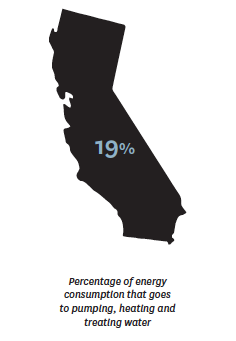
“Both seawater desalination and wastewater reuse have their challenges. Neither is easy or cheap,” Childress says. And energy consumption isn’t just expensive, it also could increase greenhouse gas emissions.
Then there’s the matter of how much water we’re using from our underground aquifers. Getting a better handle on that is important, according to Sanders.
Until this year, California was the only Western state that didn’t regulate groundwater at the state level. Officials had very little data on how much water was being sucked from beneath the ground, as this usage largely was unmetered.
In 2014, Gov. Jerry Brown signed a series of bills to create a framework for managing California’s groundwater aquifers. However, in the meantime, groundwater pumping has reached unprecedented levels due to the drought, especially in agricultural regions, and experts say it’s being pumped out faster than it can be replenished.
“You can’t manage what you can’t measure,” says Sanders, using the analogy of a person who uses a checking account without knowing how much money he has or how much is in the bank. We can’t simply hope that the cash doesn’t run out. Strengthening how agricultural water use is measured is crucial to sustaining the state’s water supply, she says.
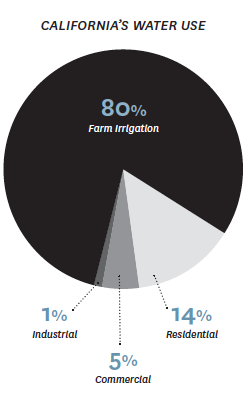
“The elephant in the room is agriculture,” adds Sanders, noting that 80 percent of California’s water goes to irrigate farms. The other 20 percent goes to urban use. “We have to make serious conservation efforts in agriculture to make any dent.”
Looking more closely at urban water use, residential use accounts for 14 percent of total statewide water use, followed by commercial use at 5 percent and industrial at 1 percent.
Half of the state’s 20 percent chunk of urban water use, Sanders says, goes to outdoor purposes like keeping grass, plants and trees lush. But, to look at this another way, if every homeowner and office landlord in the state suddenly decided to do away with lawns and landscaping, the total amount of water saved only would account for 10 percent of the state’s current total water use—and that’s not enough to solve the water problem on its own.
That doesn’t mean people and businesses shouldn’t try to conserve water, Sanders and other USC scholars say. Every drop counts, especially since lawns are largely aesthetic, unlike working farms.
Pirbazari, the water purification expert, says Southern Californians need to be educated at an early age about water conservation, recycling and reuse.
“People have to understand that they have to change their habits when it comes to how they use water,” he says. “People are not in the habit of looking at water as a precious commodity. Now, it seems, they gradually are starting to.”
Like Sanders, Pirbazari advocates for better management of the state’s groundwater supplies, and says improvements also are needed in how we manage runoff from melted snow and rainstorms.
Addressing the issue aggressively for six months and then stopping and not working on it until the next crisis happens won’t be enough.
Massoud Pirbazari
Whether it’s investing more in desalination plants or recycling wastewater, or expanding the use of “greywater” (water from showers, baths and kitchen sinks that can be recycled for landscape irrigation and other uses), the state needs to be persistent and purposeful in its management efforts to solve the crisis, Pirbazari says.
“We accept that climate change is happening, that the gradual warming of the planet is not going to be reversed,” Pirbazari adds. “We are in a dire situation. And drought is a major global problem. Addressing the issue aggressively for six months and then stopping and not working on it until the next crisis happens won’t be enough.”
Working together
As a veteran of California’s water wars and negotiations, Julie Spezia ’84, has faith in the state’s savvy thinkers.
“There are some really smart people who are planning and making sure that the water needs of Southern California, as well as the entire state, can be met moving forward,” says Spezia, a consultant to the Metropolitan Water District of Southern California and the California Department of Water Resources. “I actually think we can muddle our way through this.
“We know what the problem is and what the possible solutions are. We just have to get there,” continues Spezia, whose consulting includes work on the Bay Delta Initiative, which aims to address water quantity and quality, as well as the habitat restoration needs of the Bay Delta region near Sacramento.
Spezia says all regions of the state need to work together on the water issue, from making necessary investments in the delivery infrastructure to improving conservation efforts. She notes that over the past two decades, Southern Californians have cut enough of their water use to more than make up for the added demand for water caused by the region’s population growth.
And despite the prospects of a prolonged drought, she believes there’s “enough water in the state if we carefully manage it and if we make key investments.”
Sanders says scientific innovation alone won’t be enough to fix the water problem. It will come down to making tough choices. “We have the technology and solutions to make our situation better,” she says. “Are we willing to conserve more, pay more for water, maybe even get rid of our lawns?
“It’s a matter of not only having the political will, but everyone doing their own part.”
TOP PHOTO: Reverse osmosis filters used in water treatment plants. Photo by Denguy/Getty Images

